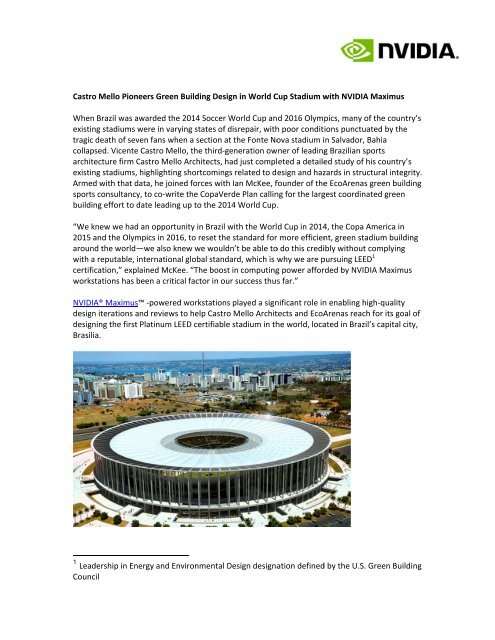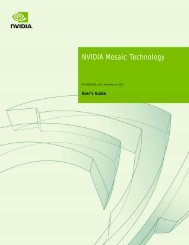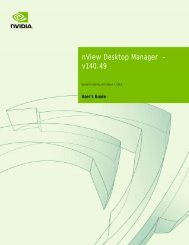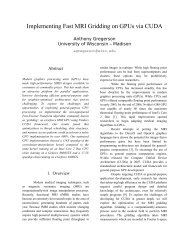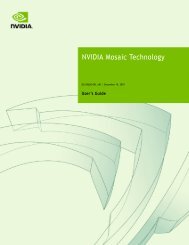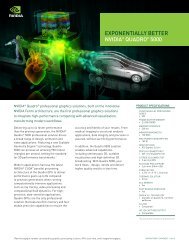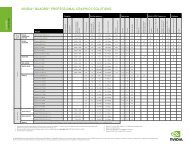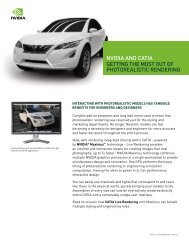Castro Mello Architects - nVIDIA
Castro Mello Architects - nVIDIA
Castro Mello Architects - nVIDIA
Create successful ePaper yourself
Turn your PDF publications into a flip-book with our unique Google optimized e-Paper software.
<strong>Castro</strong><br />
<strong>Mello</strong> Pioneers Green Building Design in World Cup Stadium with NVIDIA Maximus<br />
When<br />
Brazil was awarded the 2014 Soccer World Cup and 2016 Olympics, many of<br />
the country’ ’s<br />
existing stadiums were in varying states of disrepair, withh poor conditions punctuated by the<br />
tragic<br />
death of seven fans when<br />
a section at the Fonte Nova stadium in Salvador, Bahia<br />
collapsed. Vicente <strong>Castro</strong> <strong>Mello</strong>, the third‐generation owner of leading<br />
Brazilian sports<br />
architecture firm <strong>Castro</strong> <strong>Mello</strong> <strong>Architects</strong>, had just completed a detailed study of his country’s<br />
existing stadiums, highlighting shortcomings<br />
s related to design and hazards in structural integrity.<br />
Armed with that data, he joined<br />
forces with Ian McKee, founder of the<br />
EcoArenas green building<br />
sportss consultancy, to co‐write the CopaVerde Plan calling for the largest coordinated green<br />
building effort to date leading up to the 2014 World Cup. .<br />
“We knew we had an opportunity in Brazil with the World Cup in 2014, the Copa America in<br />
2015 and the Olympics in 2016,<br />
to reset the standard for more efficient, green stadium building<br />
around the world— —we also knew we wouldn’t be able too do this credibly without complying<br />
with a reputable, international<br />
global standard, which is why we are pursuing LEED<br />
1<br />
certification,” explained McKee. “The boost in computingg power afforded by NVIDIA Maximus<br />
workstations has been a critical<br />
factor in our<br />
success thuss far.”<br />
NVIDIA® Maximus<br />
‐powered workstations<br />
played a significant role in<br />
enabling high‐quality<br />
design<br />
iterations and reviews to<br />
help <strong>Castro</strong> <strong>Mello</strong> <strong>Architects</strong> and EcoArenas reach for its goal of<br />
designing the first Platinum LEED certifiable stadium in the world, located in Brazil’ ’s capital city,<br />
Brasilia.<br />
1 Leadership in Energy and Environmental Design designation definedd by the U.S. Green Building<br />
Council
Challenge<br />
Hundreds of sports architectural design firms around the world competed to win a bid for one of<br />
Brazil’s many new stadiums. <strong>Castro</strong> <strong>Mello</strong> <strong>Architects</strong> was awarded the design of the coveted<br />
‘Estádio Nacional de Brasilia’. Determined to show the world that high performance stadiums<br />
could be profitable examples of green building success, the team needed to devise inventive<br />
ways to create building efficiencies in the areas of energy consumption, water usage, waste and<br />
transportation, among others.<br />
In order to improve the stadium’s overall design, spectator experience and environmental<br />
performance; several lighting, climate, airflow and material tests had to be conducted from the<br />
earliest design phases. This testing required compute‐intensive rendering of hundreds of<br />
computer generated (CG) images.<br />
When <strong>Castro</strong> <strong>Mello</strong> <strong>Architects</strong> began developing their designs, the initial workstations used were<br />
Dell Precision T7500s with consumer grade GPUs running Autodesk Revit for design, and<br />
Autodesk 3ds Max for producing rendered stills. One architect would start by creating 3D<br />
structure designs in Revit. Then, a second architect on a separate workstation would take those<br />
designs and run real‐world light studies using Autodesk 3ds Max, and render them out on the<br />
CPU to determine how to build the stadium to get the most out of natural lighting, which is<br />
essential for LEED certification.<br />
“There was simply not enough computing power with this system to create images from our<br />
designs with any efficiency,” said <strong>Castro</strong> <strong>Mello</strong>. “It was taking us 8 hours to generate a single<br />
frame and we didn’t have a practical way to view changes that could meet the demands of our<br />
schedule. If there was something flawed in our design, we would often have to waste an entire<br />
overnight render run before we became aware of the problem—only to have to start over the<br />
next day.”<br />
Solution<br />
When approaching the stadium design, <strong>Castro</strong> <strong>Mello</strong> and EcoArenas began conducting bioclimactic<br />
studies to analyze the weather in Brasilia and align the results with optimal building<br />
and roof designs.<br />
“When I was in the climate research phase, I learned that some meteorologists and scientists<br />
working with heavy processing demands were using NVIDIA Tesla GPUs. Already armed with<br />
Quadro cards on our workstations, we added Tesla cards bringing the workstations up to the<br />
Maximus‐powered configuration to see how it would improve our render times ” explained<br />
<strong>Castro</strong> <strong>Mello</strong>. “The results were dramatic. Working in 3ds Max and leveraging the GPU based<br />
renderer, iray, we were able to generate test renders of design revisions in as fast as 30 seconds,<br />
a process that was previously taking us up to eight hours on the CPU.”<br />
This opened up an incredible opportunity for <strong>Castro</strong> <strong>Mello</strong> architects, three of whom<br />
immediately started working on Maximus‐enabled workstations. “We had to do extensive<br />
testing of varying sun positions and lighting conditions. Next we analyzed that information<br />
which was then translated into different design permutations to assess how best to maximize
natural resources. This process helped significantly reduce the overall energy load of the<br />
stadium,” continued <strong>Castro</strong> <strong>Mello</strong>.<br />
Adopting Maximus‐enabled workstations also allowed <strong>Castro</strong> <strong>Mello</strong> <strong>Architects</strong> to run both Revit<br />
and 3ds Max with iray simultaneously on a single workstation, significantly boosting workflow<br />
speed<br />
and efficiency. With the ability to run both programs on one system, designers could<br />
conduct real‐world<br />
lighting tests in 3ds Max or analysis of energy impact in Ecotect, and then<br />
instantly make necessary design<br />
changes in Revit, streamlining the design process and providing<br />
the enhanced speed necessary to complete the project on time and with as many green features<br />
as possible.<br />
In addition to extensive light studies, this computer analysis and the rendered images were used<br />
to demonstrate how the stadium could capture and reuse rainwater, improve airflow and<br />
ventilation, reducee waste, and enable explorations to determine overall color, pattern and<br />
material choices for stadium seating.
Impact<br />
At the front end of the project, the CopaVerde Plan helped sway FIFA to require some form of<br />
green building certification to be included in all submitted designs; to date, ten of the twelve<br />
new stadiums are pursuing LEED certification, with <strong>Castro</strong> <strong>Mello</strong>’s Estádio Nacional de Brasilia<br />
(slated for completion in February of 2013) going for the highest—Platinum—designation.<br />
With the help of NVIDIA Maximus technology, <strong>Castro</strong> <strong>Mello</strong> <strong>Architects</strong> made some unanticipated<br />
changes to their original stadium designs. “After running sunlight and reflection studies to figure<br />
out exactly where the sun’s heat was impacting the building, we discovered that by simply<br />
drawing back the glass façade of the VIP boxes, and creating patios instead, we could<br />
significantly limit solar heat gain, reducing internal air conditioning demands,” explained <strong>Castro</strong><br />
<strong>Mello</strong>.<br />
Their research and use of a Maximus workstation also enabled the team to develop a system to<br />
collect rainwater runoff from the entire site, treating the captured water and redirecting it for<br />
use in restrooms, field irrigation and general stadium cleaning. The result is a dramatic<br />
reduction in potable water use. Other eco‐friendly components include the largest stadium solar<br />
photovoltaic system in the world at 2.544 MW.<br />
With these building efficiencies, EcoArenas, LLC estimates that the Brasilia Stadium will realize<br />
approximate energy savings of up to 120% per year becoming the first Net Zero Energy stadium<br />
in the world and reduce potable water consumption by more than 80%.<br />
“Speed and being able to preview and revise our designs in real‐time on the same workstation<br />
were essential on this project. That’s really where we were able to benefit from the boost in<br />
computing power—being able to solve design decisions in one sitting,” concluded <strong>Castro</strong> <strong>Mello</strong>.<br />
“We are a relatively small team, only six architects, and armed with the best technology, we’re<br />
able to compete on a global scale. The playing field has been leveled where small, but highly<br />
qualified teams, can compete with much larger architectural firms. The ability to turn around<br />
design iterations so quickly with a Maximus workstation was essential in designing what we<br />
hope will be the greenest stadium in the world.”


